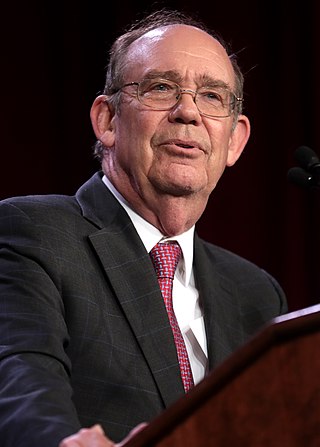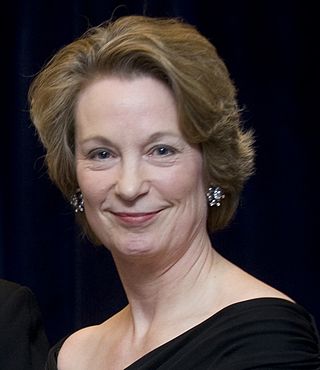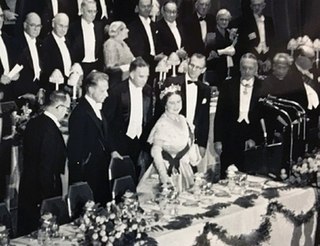
Dwight David Eisenhower, nicknamed Ike, was an American military officer and statesman who served as the 34th president of the United States from 1953 to 1961. During World War II, he was Supreme Commander of the Allied Expeditionary Force in Europe and achieved the five-star rank as General of the Army. Eisenhower planned and supervised two of the most consequential military campaigns of World War II: Operation Torch in the North Africa campaign in 1942–1943 and the invasion of Normandy in 1944.

The Council on Foreign Relations (CFR) is an American think tank specializing in U.S. foreign policy and international relations. Founded in 1921, it is an independent and nonpartisan nonprofit organization. CFR is based in New York City, with an additional office in Washington, D.C. Its membership has included senior politicians, secretaries of state, CIA directors, bankers, lawyers, professors, corporate directors, CEOs, and prominent media figures.

Thomas Sovereign Gates Jr. was an American politician and diplomat who served as Secretary of Defense from 1959 to 1961 and Secretary of the Navy from 1957 to 1959, both under President Dwight D. Eisenhower. During his tenure as Secretary of Defense, he established a task force to set nuclear target priorities. He also authorized U-2 reconnaissance flights, including the flight of Francis Gary Powers.

Milton Stover Eisenhower was an American academic administrator. He served as president of three major American universities: Kansas State University, Pennsylvania State University, and Johns Hopkins University. He was the youngest brother of, and advisor to, U.S. President Dwight D. Eisenhower.

The Commonwealth Club World Affairs of California is a non-profit, non-partisan educational organization based in Northern California. Founded in 1903, it is the oldest and largest public affairs forum in the United States. Membership is open to everyone.

The First Taiwan Strait Crisis was a brief armed conflict between the People's Republic of China (PRC) and the Republic of China (ROC) in Taiwan. The conflict focused on several groups of islands in the Taiwan Strait that were held by the ROC but were located only a few miles from mainland China.

Dwight David Eisenhower II is an American author, public policy fellow, lecturer at the University of Pennsylvania, and eponym of the U.S. presidential retreat Camp David. He is the grandson of President Dwight D. Eisenhower and First Lady Mamie Eisenhower, and a son-in-law of President Richard Nixon and First Lady Pat Nixon.
Grayson Louis Kirk was an American political scientist who served as president of Columbia University during the Columbia University protests of 1968. He was also an advisor to the State Department and instrumental in the formation of the United Nations.

The School of International and Public Affairs (SIPA) is the international affairs and public policy school of Columbia University, a private Ivy League university located in Morningside Heights, Manhattan, New York City. SIPA offers Master of International Affairs (MIA) and Master of Public Administration (MPA) degrees in a range of fields, as well as the Executive MPA and PhD program in Sustainable Development.

Dwight D. Eisenhower's tenure as the 34th president of the United States began with his first inauguration on January 20, 1953, and ended on January 20, 1961. Eisenhower, a Republican from Kansas, took office following his landslide victory over Democratic nominee Adlai Stevenson in the 1952 presidential election. Four years later, in the 1956 presidential election, he defeated Stevenson again, to win re-election in a larger landslide. Eisenhower was limited to two terms and was succeeded by Democrat John F. Kennedy, who won the 1960 presidential election.

The Dwight D. Eisenhower School for National Security and Resource Strategy, formerly known as the Industrial College of the Armed Forces (ICAF), is a part of the National Defense University. It was renamed on September 6, 2012, in honor of Dwight D. Eisenhower who graduated from this school when it was previously known as the Army Industrial College.
The Institute for Social and Economic Research and Policy (ISERP) is the research arm of the social sciences at Columbia University, formerly known as the Paul F. Lazarsfeld Center for the Social Sciences. ISERP works to produce pioneering social science research and to shape public policy by integrating knowledge and methods across the social scientific disciplines. ISERP organizes an active intellectual community at Columbia University through its Faculty Fellows program, research centers, projects, and training initiatives.

Susan Elaine Eisenhower is an American consultant, author, and expert on international security, space policy, energy, and relations between the Russian Federation and the United States of America. She is the daughter of John Eisenhower and the granddaughter of President Dwight D. Eisenhower.

Stephen H. Hess is a senior fellow emeritus in the Governance Studies program at the Brookings Institution. He studies media, the U.S. presidency, political dynasties and the U.S. government. He first joined Brookings in 1972 and was distinguished research professor of media and public affairs at the George Washington University (2004–2009). He served on Presidents Dwight D. Eisenhower and Richard Nixon's White House staff and as an adviser to Presidents Gerald R. Ford and Jimmy Carter.
The National Conference on Citizenship (NCoC) is a non-partisan, non-profit organization dedicated to strengthening civic life in America. They pursue their mission through a nationwide network of partners involved in a Civic Health Initiative, annual cross-sector conferences, and engagement with a broad spectrum of individuals and organizations interested in utilizing civic engagement principles and practices to enhance their work. Connecting people for the purpose of strengthening civic life is NCoC's goal. At the core of NCoC's joint efforts is the belief that every person has the ability to help his or her community and country thrive.
Eisenhower Fellowships (EF) is a private, non-profit organization created in 1953 by a group of American citizens to honor President Dwight D. Eisenhower for his contribution to humanity as a soldier, statesman, and world leader. The organization describes itself as an "independent, nonpartisan international leadership organization".
The United States foreign policy of the Dwight D. Eisenhower administration, from 1953 to 1961, focused on the Cold War with the Soviet Union and its satellites. The United States built up a stockpile of nuclear weapons and nuclear delivery systems to deter military threats and save money while cutting back on expensive Army combat units. A major uprising broke out in Hungary in 1956; the Eisenhower administration did not become directly involved, but condemned the military invasion by the Soviet Union. Eisenhower sought to reach a nuclear test ban treaty with the Soviet Union, but following the 1960 U-2 incident the Kremlin canceled a scheduled summit in Paris.
Gilbert Yale Steiner was an American scholar of social policy who served as the fourth (interim) president of the Brookings Institution from 1976 to 1977.
Lawrence Henry Chamberlain was an American political scientist and academic administrator. He was the former dean of Columbia College and vice president of Columbia University.

The Columbia University Bicentennial was a series of celebrations in 1954 commemorating the 200th anniversary of the founding of Columbia University. Its scale was global, with participation from over 750 domestic and 350 foreign universities, libraries, and museums. In New York City, bicentennial events centered around three convocations in January, June, and October, interspersed with conferences, concerts, and other ceremonies. In order to spread the theme of the Bicentennial, "Man's Right to Knowledge and the Free Use Thereof", across the United States, the university created several network television and radio shows, including the Peabody Award-winning series Man's Right to Knowledge. The celebrations received heavy media coverage, both in the United States and abroad.











